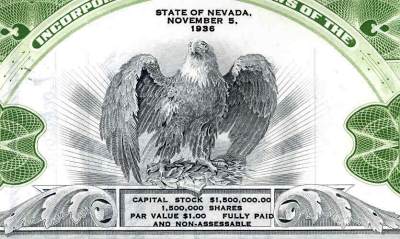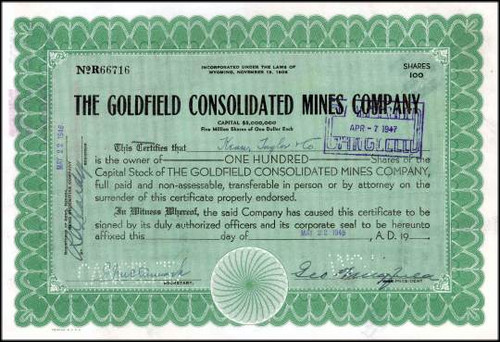Beautifully engraved certificate from the Getchell Mine, Inc. issued in 1946. This historic document has an ornate border around it with a vignette of an eagle. This item is hand signed by the Company's President ( George Wingfield ) and Secretary and is over 60 years old. The certificate was issued to and signed by George Hewitt Myers on the verso. 
Certificate Vignette GETCHELL MINE Discovered in 1933 and quickly purchased by Noble Getchell. Quickly became a huge operation with a 400-ton mill and a company town with almost a hundred homes. The mine produced copper, silver, arsenic, tungsten and gold. Operations continued until 1967. The mill was taken down and only foundations remain. On May 27, 1999 Placer Dome completed a merger with Getchell Gold Corporation, resulting in Placer Dome owning 100% of the Getchell gold property. Getchell is an underground gold mine located in the Potosi Mining District, Humboldt County, Nevada The Getchell Mine has produced more than $60 million and counting making it one of the richest districts in Nevada. On October 25, 2001, Newmont Mining Corporation and Getchell Gold Corporation signed a letter of intent under which Newmont will buy ore from the Getchell mine for processing at Newmont's adjacent Twin Creeks mine. Getchell is 100% owned by Placer Dome George Hewitt Myers George Hewitt Myers was a successful businessman. In 1925 he founded The Textile Museum located in Washington DC with a collection of 275 rugs and 60 related textiles drawn from the traditions of non-Western cultures. With the establishment of The Textile Museum, Myers demonstrated his commitment to championing the appreciation of textiles as works of art. At the time of his death in 1957, his collection numbered 500 rugs and 3,500 textiles. Since then, the Museum has broadened its' holdings to better represent the full spectrum of non-Western textile arts. Today the Museum's collections number more than 17,000 objects and span 5,000 years, dating from 3,000 B.C.E. to the present. George Wingfield When George Wingfield came to Northern Nevada in the late 1800's no one knew what impact he would eventually have on this western state. Born in Arkansas in 1876, by 1906 Wingfield had become a prominent (and rich) businessman not only in Nevada but also throughout the U.S. As owner of the Goldfield Consolidated Mines Company, George became a multi-millionaire by age 30 and for a time owned every bank in the state. One of George's favorite pastimes was to bring his favorite hunting dogs and his best friends (such as Herbert Hoover, Bernard Baruch and others) to his "Nevada Oasis", the Spanish Springs Valley Ranch that is now Wingfield Springs. For almost a quarter of a century he devoted his efforts to improving his ranch, extending ponds, building a first class facility for his prize-winning quarterhorses and Labrador retrievers and enjoying the area's natural beauty from the original ranch house in the old cottonwood grove that remains today. George Wingfield Owner & Operator of Nevada George Wingfield has been a major figure in Nevada history at least since 1912, when he turned down an appointment to the United States Senate. A political and economic titan, he made a tremendous fortune in the gold fields of central Nevada in the early twentieth century, and went on to own a chain of banks, numerous ranches, and several Reno hotels. Active in political party circles in the 1920's, he became the reputed boss of both Democratic and Republican parties. George Wingfield's power was legendary in his own time, and was publicly demonstrated when the collapse of his twelve banks in 1932 almost led to the economic ruin of the state. During his lifetime, there were at least two offers to make a Hollywood movie based on his experiences. For a period of years early in the 20th century, Wingfield could be described without exaggeration as the "Owner and Operator of Nevada." His legacy to the state has been controversial. Some have revered him as Nevada's benevolent "friend in need." Others have condemned him as a "sagebrush caesar," a man who dominated the state politically "as arbitrarily as the czar ruled Russia." Born in Arkansas in 1876, he died in Reno in 1959 after a quintessential rags-to-riches career. From a ranch boyhood in southeastern Oregon through an early career as a saloon keeper and a professional gambler, Wingfield emerged as a daring capitalist with the 1906 formation of Goldfield Consolidated Mines Company, in partnership with U.S. Senator George S. Nixon. This mine made both men multi-millionaires. George Wingfield's financial acumen was great and his fortune legendary. National newspapers celebrated him as "Nevada's Napoleon." A friend to prominent men, including Bernard Baruch and Herbert Hoover, Wingfield became a significant power in the state of Nevada because he remained in the state with all of his money, instead of leaving us as other mining barons had. His power became controversial, however, as his political activities gradually remade the state in his own image. Fiscally conservative, but socially liberal, George Wingfield supported horse racing, liberalized divorce, and open gambling in Nevada. Many others did not, but his investments gave him tremendous influence in a sparsely populated state. His lifelong opposition to labor unions, for instance, was surely implicated in the suppression of the miners' union in Goldfield in 1908. By the 1930s, when his banks had difficulty, Wingfield was so bitterly resented that all attempts to reorganize and reopen his banks failed. In 1935, defeated and shorn of all political power, Wingfield declared personal bankruptcy. Although a second fabulous gold mine, the Getchell, brought him another fortune in the 1940s and 50s, he never recovered the political authority he had enjoyed at the height of his power in the 1920s. When he died in 1959, however, he had the satisfaction of seeing around him a flourishing economy based on the gambling-and-divorce related tourism he had worked so hard to promote. During his later years, one of Wingfield's favorite places was the property northeast of Reno that he called Spanish Springs Ranch. He bought the land in August 1935, from the estate of the colorful Reno mayor E.E. Roberts, who had used it as a duck preserve. Wingfield owned it until his death in 1959, when he left it to his wife, Roxy Thoma Wingfield. For almost a quarter-century he devoted his efforts to improving it, extending the ponds to attract waterfowl, building hunting blinds, and inviting numerous friends to shoot ducks and grouse, which was his recreational passion. At Spanish Springs Ranch he also bred prize-winning quarterhorses and labrador dogs. He gave the latter to friends throughout the country. The ranch was his constant weekend retreat, and he probably would have lived there year round if his wife had permitted it. The modest house at the center of the old grove provided a beautiful view of the mountains at sunset, and a vista across the entire valley that he had done so much to shape. Wingfield Springs Significant Dates in History 1876 George Wingfield born outside Ft. Smith, Arkansas 1896 George Wingfield moves permanently to Nevada from his father's ranch near Lakeview, Oregon; makes his living as a cowhand, saloon owner, and gambler 1901 George Wingfield moves to Tonopah and makes his living as a professional gambler 1902 George Wingfield begins to invest in real estate, banks, and mining stocks, in partnership with Republican political figure George S. Nixon, later a U.S. Senator; the partnership, never legally formalized, was known as Nixon & Wingfield 1906 Nixon & Wingfield secures the capital to combine six of the richest gold mines in Goldfield, NV and form the Goldfield Consolidated Mines Company; for a time in the early 20th century it is among the 20 largest industrial companies in the U.S.; George Wingfield's fortune said to be $25 million at age 30, and in an era before Federal income taxes 1907 Strikes against Goldfield mines proclaimed by the Industrial Workers of the World (IWW) are ended and the union suppressed, only after Federal troops are summoned by the mine owners on the pretext of an emergency 1908 George Wingfield marries Maude Murdoch and moves to Reno 1909 Nixon & Wingfield is amicably dissolved; Wingfield keeps mining properties, Nixon takes banks 1912 George Wingfield turns down appointment to fill out Nixon's term as U.S. Senator, choosing instead to remain in Nevada; begins to buy Nevada banks from Nixon Estate 1914 George Wingfield buys Meadowbrook Ranch, near Susanville, CA, as summer retreat; founds thoroughbred racing stable, Nevada Stock Farms 1915 Reno Securities Co. is formed to buy Reno's Golden Hotel; Wingfield secures legislation to legalize pari-mutual betting on horse races in Nevada 1920's George Wingfield becomes active in Republican national politics, invests in banks, fuel refining, bonding company, road construction companies, and numerous other fields 1927 Reno Securities Co. builds Reno's most elegant hotel, the Riverside 1927 Cole-Malley embezzlement of over $500,000 from State of Nevada revealed, Wingfield's cashier at the Carson Valley Bank is implicated; George Wingfield personally deposits the full amount of the defalcation until matters can be sorted out 1928 George Wingfield elected as regent for the University of Nevada; Cole-Malley case settled by special session of state legislature; Wingfield pays 1/3 of the loss, state tax rates must be raised to cover the remaining share; case engenders much public comment and resentment of George Wingfield 1929 George Wingfield and Maude Murdoch Wingfield divorce 1930's Livestock industry enters depression due to falling prices, drought conditions 1930 George Wingfield marries Roxy Thoma 1931 Nevada re-legalizes gambling, reduces divorce residency period from three months to six weeks; state attracts considerable negative commentary in national press 1932 George Wingfield chain of banks collapses after flagship Reno National Bank (now Planet Hollywood) is unable to repay RFC loans; political opposition to Wingfield, and suspicion about bank failures, defeats attempts to reorganize and reopen the banks 1935 George Wingfield files for personal bankruptcy; Noble Getchell approaches him to invest in a mining property that proves to be another major gold mine, Wingfield secures funds from Bernard Baruch; Reno Securities Co. buys Spanish Springs Ranch 1940's Getchell Mine prospers during World War II as source for arsenic and tungsten; George Wingfield supervises hotel properties, enjoys shooting at Spanish Springs Ranch, begins raising quarterhorses and labrador dogs 1944 George Wingfield marks formal recovery from bankruptcy by redeeming the Reno Securities Company from the Crocker National Bank in San Francisco 1946 Gala George Wingfield 70th birthday celebration in Reno brings congratulatory telegrams from Herbert Hoover and Bernard Baruch 1955 George Wingfield sells Reno Securities Company and the Riverside Hotel, but retains the Spanish Springs Ranch 1957 George Wingfield awarded honorary Doctor of Mining Economics degree from the University of Nevada 1959 After suffering a stroke, George Wingfield dies in Reno on Christmas Day

Certificate Vignette













